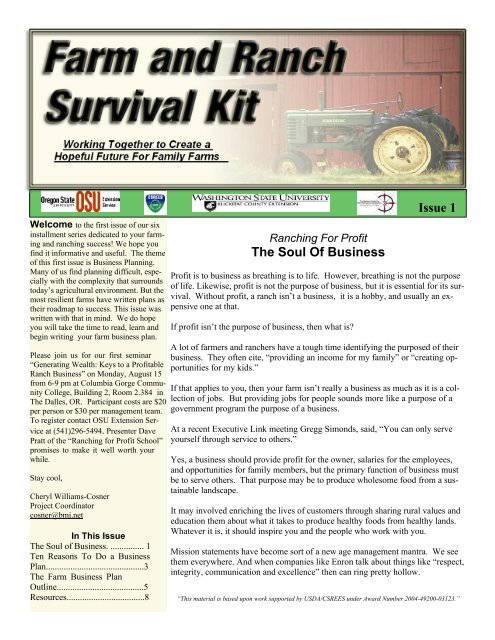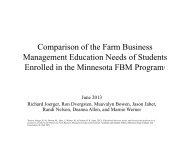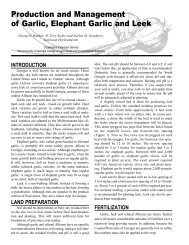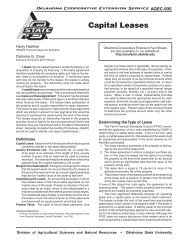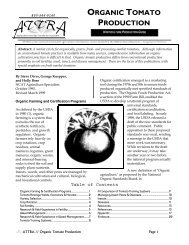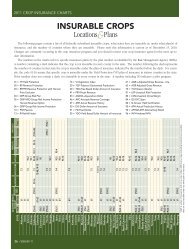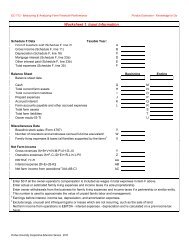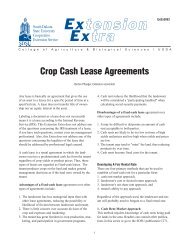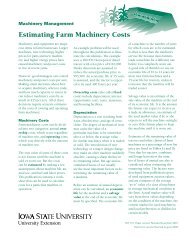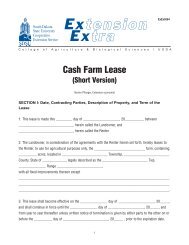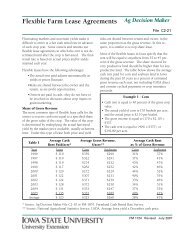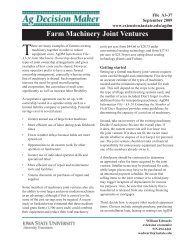Farm and Ranch Survival Kit - National Ag Risk Education Library
Farm and Ranch Survival Kit - National Ag Risk Education Library
Farm and Ranch Survival Kit - National Ag Risk Education Library
Create successful ePaper yourself
Turn your PDF publications into a flip-book with our unique Google optimized e-Paper software.
Working Together to Create a<br />
Hopeful Future For Family <strong>Farm</strong>s<br />
Welcome to the first issue of our six<br />
installment series dedicated to your farming<br />
<strong>and</strong> ranching success! We hope you<br />
find it informative <strong>and</strong> useful. The theme<br />
of this first issue is Business Planning.<br />
Many of us find planning difficult, especially<br />
with the complexity that surrounds<br />
today’s agricultural environment. But the<br />
most resilient farms have written plans as<br />
their roadmap to success. This issue was<br />
written with that in mind. We do hope<br />
you will take the time to read, learn <strong>and</strong><br />
begin writing your farm business plan.<br />
Please join us for our first seminar<br />
“Generating Wealth: Keys to a Profitable<br />
<strong>Ranch</strong> Business” on Monday, August 15<br />
from 6-9 pm at Columbia Gorge Community<br />
College, Building 2, Room 2.384 in<br />
The Dalles, OR. Participant costs are $20<br />
per person or $30 per management team.<br />
To register contact OSU Extension Service<br />
at (541)296-5494. Presenter Dave<br />
Pratt of the “<strong>Ranch</strong>ing for Profit School”<br />
promises to make it well worth your<br />
while.<br />
Stay cool,<br />
Cheryl Williams-Cosner<br />
Project Coordinator<br />
cosner@bmi.net<br />
In This Issue<br />
The Soul of Business. ............... 1<br />
Ten Reasons To Do a Business<br />
Plan............................................3<br />
The <strong>Farm</strong> Business Plan<br />
Outline.......................................5<br />
Resources...................................8<br />
<strong>Ranch</strong>ing For Profit<br />
The Soul Of Business<br />
Issue 1<br />
Profit is to business as breathing is to life. However, breathing is not the purpose<br />
of life. Likewise, profit is not the purpose of business, but it is essential for its survival.<br />
Without profit, a ranch isn’t a business, it is a hobby, <strong>and</strong> usually an expensive<br />
one at that.<br />
If profit isn’t the purpose of business, then what is?<br />
A lot of farmers <strong>and</strong> ranchers have a tough time identifying the purposed of their<br />
business. They often cite, “providing an income for my family” or “creating opportunities<br />
for my kids.”<br />
If that applies to you, then your farm isn’t really a business as much as it is a collection<br />
of jobs. But providing jobs for people sounds more like a purpose of a<br />
government program the purpose of a business.<br />
At a recent Executive Link meeting Gregg Simonds, said, “You can only serve<br />
yourself through service to others.”<br />
Yes, a business should provide profit for the owner, salaries for the employees,<br />
<strong>and</strong> opportunities for family members, but the primary function of business must<br />
be to serve others. That purpose may be to produce wholesome food from a sustainable<br />
l<strong>and</strong>scape.<br />
It may involved enriching the lives of customers through sharing rural values <strong>and</strong><br />
education them about what it takes to produce healthy foods from healthy l<strong>and</strong>s.<br />
Whatever it is, it should inspire you <strong>and</strong> the people who work with you.<br />
Mission statements have become sort of a new age management mantra. We see<br />
them everywhere. And when companies like Enron talk about things like “respect,<br />
integrity, communication <strong>and</strong> excellence” then can ring pretty hollow.<br />
“This material is based upon work supported by USDA/CSREES under Award Number 2004-49200-03123.”
<strong>Ranch</strong>ing For Profit: The Soul Of Business (con’t)<br />
But just because some companies talk the talk but fail to walk the walk doesn’t mean that identifying your business’ core<br />
purpose isn’t important.<br />
Why is this so critical <strong>and</strong> what good does it do for a business to have <strong>and</strong> work to fulfill a mission statement? The bottom<br />
line is that it can dramatically improve the bottom line.<br />
As I’ve already said, there is more to life <strong>and</strong> business than money. Finding that higher purpose usually leads to increased<br />
profit.<br />
In their book “Built to Last” the authors, James Collins <strong>and</strong> Jerry Porras identified “visionary” companies. These were<br />
companies that had identified <strong>and</strong> pursued a vision beyond profit <strong>and</strong> had made an indelible impression in their field.<br />
Then they compared these companies to other highly successful companies in their respective fields. Among other things<br />
they found that the companies that pursued a vision beyond profit were more than twice as profitable as the purely profit<br />
driven companies.<br />
There’s another critical reason to clearly define the purposed of your business. It is key to keeping you energy level high<br />
<strong>and</strong>, as Joel Salatain puts it, to “romancing the next generation” back to the ranch.<br />
As important as profit is to business, people are not motivated by money. In fact, money is negative motivator. Under<br />
pay someone <strong>and</strong> they’ll be upset. Pay someone more than their worth <strong>and</strong> you won’t get more or better work from them.<br />
Stan Parsons used to tell me, you can buy someone’s h<strong>and</strong>s, but you can’t buy their heart <strong>and</strong> that’s where their loyalty<br />
lies. Nor can you buy their mind, <strong>and</strong> that’s where their creativity originates.<br />
So how do you learn loyalty <strong>and</strong> unleash creativity?<br />
Recognition, assigning responsibility <strong>and</strong> delegating authority are big pieces of this picture. In fact that’s why monetary<br />
bonus program can be so effective. It isn’t the bonus that motivates people as much as the recognition of achievement<br />
that the bonus implies.<br />
Another huge piece of the motivation puzzle is purpose. People want to work toward something bigger than themselves<br />
<strong>and</strong> bigger than you. Employees don’t go to work each day because they want to make their boss rich. They go to work<br />
because they need a paycheck. But they show up on time, do quality work enthusiastically, come up with ideas to improve<br />
their own performance <strong>and</strong> stay until the job is done, when they believe in the purpose behind their work.<br />
People aren’t motivated by money to reach for the stars. They are motivated to reach for the stars, because the stars excite<br />
them. The passion this creates is key to keeping energy high when times get tough.<br />
Economics is the heart of the business. But a business without purpose doesn’t have a soul. A sustainable business has to<br />
have a heart, but it’s also got to have a soul.<br />
David Pratt, is President of <strong>Ranch</strong> Management Consultants, Inc. In Fairfield, California, <strong>and</strong> teaches the <strong>Ranch</strong>ing for<br />
Profit School. For more information call: 707-429-2292.<br />
E-Mail: pratt@ranch management.com or visit www.ranchmanagement.com<br />
2
Ten Painless Steps to Start <strong>and</strong> Finish Your Business Plan<br />
You need to prepare a business plan for your company. Anxious to start, you immediately open your favorite word processing<br />
program. But now you’re staring at a blank screen <strong>and</strong> a blinking cursor that appears to be mocking you. Not sure<br />
where to start or what to write first, you flip the computer off <strong>and</strong> decide that tomorrow is a much better day to work on<br />
your plan. After all, the weather is much too nice to be sitting inside on a day like today.<br />
Many entrepreneurs <strong>and</strong> business owners have faced this situation before, but what to do when waiting until tomorrow to<br />
start your plan is unacceptable? Follow these 10 tried <strong>and</strong> true tips to help you complete outst<strong>and</strong>ing business plan.<br />
1. Decide why you’re writing your plan<br />
Are you raising money? Clarifying your future? Launching a new venture? Searching for strategic partners? Game-planning<br />
to destroy your competition? Whatever the reason is it’s important to get committed to the business plan writing process.<br />
Prepare for yourself a short paragraph that outlines why you are writing a business plan <strong>and</strong> why it will be great. Call<br />
it your business plan mission, it will keep you motivated <strong>and</strong> help you clarify the message you send your readers.<br />
2. Get the big picture<br />
Before accumulating mountains of research <strong>and</strong> information, take a look at your business plan through a wide-angle lens<br />
to get the big picture. Visit your local library or bookstore <strong>and</strong> bring home a few business plan books. Take a look at Internet<br />
resources, consider business plan software programs <strong>and</strong> review the SBA's business planning outline. Your goal is<br />
to get a feel for what a business plan is, what it isn’t <strong>and</strong> what to expect from your business plan. With this new insight,<br />
prepare an outline that includes the major sections <strong>and</strong> subsections that you believe should appear in your business plan.<br />
3. Grab everything that’s already h<strong>and</strong>y<br />
Dig through every computer file, box <strong>and</strong> file cabinet you have to unearth the information that’s already available to you.<br />
You’ll surprise yourself with what you find <strong>and</strong> with how nicely this step will move you forward. Consider marketing<br />
pieces you’ve prepared, press releases, related articles, industry journals, historical financials, important web sites <strong>and</strong><br />
notes or ideas you’ve accumulated over time. Don’t rate the quality of this information just gather it. At this point quantity<br />
is the name of the game, <strong>and</strong> the more you can find the better.<br />
4. Just type!<br />
Start typing thoughts, ideas, words, questions <strong>and</strong> to-dos into each section of your business plan outline. Put rough<br />
thoughts on paper <strong>and</strong> empty your brain. Don’t worry about complete sentences or proper grammar, just type. Approach<br />
this step like a brainstorming session, the more powerful the storm, the more potent your business plan. Jot down any<br />
ideas that dem<strong>and</strong> further consideration, areas that present a challenge <strong>and</strong> topics that require the input of others. Strive to<br />
place your thoughts in the most appropriate section of your business plan outline <strong>and</strong> rearrange the outline if it will be<br />
more logical for your readers.<br />
5. Prepare a rough draft<br />
Now it’s time to take your outline, the information you’ve got h<strong>and</strong>y <strong>and</strong> your brainstormed ideas <strong>and</strong> shape them into a<br />
useable rough draft. Move through your entire outline, section by section <strong>and</strong> begin writing complete sentences <strong>and</strong> paragraphs.<br />
As you work, start a Biz Plan To-Do List to keep track of topics that require in-depth research, statistics or backup<br />
information. When you’re done, print out a copy <strong>and</strong> read it a few times, revising lightly as you go. Your plan should<br />
be rather sparse, but when you’ve completed this step, you’ve truly made business planning progress.<br />
6. It’s research time<br />
Now is the time to think like a lawyer <strong>and</strong> build a case for your business plan. Your goal is to compile information <strong>and</strong><br />
research to support the claims <strong>and</strong> assertions you make in your plan. Drop by the library <strong>and</strong> ask the librarian if she knows<br />
of any sources of information that can help your cause. Schedule a meeting with a local SBA representative or a Small<br />
Business Development Center counselor. Call your local <strong>and</strong> national industry associations <strong>and</strong> track down annual reports<br />
for companies in your industry. Request product <strong>and</strong> service information from your competitors. In short, talk to anyone<br />
<strong>and</strong> everyone that might be able to help you collect information for your business plan.<br />
3
Ten Painless Steps to Start <strong>and</strong> Finish Your Business Plan (con’t)<br />
7. Start thinking about the numbers<br />
It is advisable to begin developing your pro-forma financial statements at this point. If you start any sooner, one of two<br />
things is likely to occur: 1) Your numbers will be based on pure fantasy <strong>and</strong> you’ll have to change them anyway, or 2)<br />
You’ll attempt to write your plan, do the research, revise your plan <strong>and</strong> complete your financial statements all at once <strong>and</strong><br />
none of it will get done. If you prepare your financial statements at this stage, your numbers have a much better chance of<br />
matching <strong>and</strong> supporting the text in the body of your business plan. For example, if you mention a specific marketing medium<br />
in your marketing section, you'll need to include the corresponding costs somewhere in your financials.<br />
8. Write a final draft <strong>and</strong> finish the numbers<br />
Sometimes finishing is the hardest part of completing large projects like a business plan. But if you follow the steps leading<br />
up to this one, success is just around the corner. Avoid the mistake many business planners make at this stage It is important<br />
to check, double-check <strong>and</strong> triple-check your writing for grammatical <strong>and</strong> spelling errors. Think of it this way<br />
bankers <strong>and</strong> investors will assume that you will manage your business <strong>and</strong> protect their money with the same level of care<br />
<strong>and</strong> attention that you demonstrate in your business plan. Go all out <strong>and</strong> create a document that sends a powerful message<br />
about the quality of your work.<br />
9. Set a deadline<br />
To ensure that you complete your plan, set a deadline for yourself that you can’t ignore. We suggest calling a few people<br />
you respect to ask if they would be willing to read your plan <strong>and</strong> offer suggestions. Make this arrangement with someone<br />
whom you are not particularly close with, possibly a professional acquaintance, so it’s more difficult <strong>and</strong> uncomfortable<br />
to call <strong>and</strong> delay. Ask for feedback <strong>and</strong> make it clear that honesty is what you are after. If you don’t explain this up-front,<br />
you may hear “looks good to me” essentially a waste of time for both of you. If you feel tears coming on as they serve up<br />
their advice, things are going well. Take detailed notes <strong>and</strong> refrain from crying until after the phone is back on the receiver.<br />
10. Polish your plan to perfection<br />
The comments you receive from your readers will help you to beef-up the sections of your plan that need attention. Track<br />
down any additional information you may need, incorporate the ideas that your readers offered <strong>and</strong> clarify sections or<br />
points that were not clearly conveyed. Put together an appendix if necessary, create a clean cover page <strong>and</strong> table of contents<br />
<strong>and</strong> include a non-disclosure form. Lastly, prepare a one-page executive summary that encapsulates the highlights of<br />
your entire business plan <strong>and</strong> place it up front. Walk into your local print shop like you own the place <strong>and</strong> professionally<br />
print <strong>and</strong> bind as many copies of your plan as you need. Congratulations, you’re the proud owner of an excellent business<br />
plan.<br />
Bill Fideccia is principle owner of his business planning consulting firm, Bizplanit. For more information <strong>and</strong> resources<br />
on business planning, visit www.bizplanit.com.<br />
4
<strong>Farm</strong> Business Plans: A Guide for Creating Your Plan<br />
When was the last time you sat down <strong>and</strong> evaluated your farm on paper? A farm business plan can help you to develop a<br />
clear <strong>and</strong> precise description of all aspects of your operation. It enables you to see the potential profitability of your operation<br />
<strong>and</strong> explain it to others. It puts information at your fingertips while assisting you to develop a stronger underst<strong>and</strong>ing<br />
of the industry as a whole. A farm business plan can help you to assess the potential of new markets <strong>and</strong> production<br />
methods on paper so you can underst<strong>and</strong> the risks without loss to your operation. A farm business plan will assist you to<br />
set <strong>and</strong> achieve goals for your operation.<br />
Why A <strong>Farm</strong> Business Plan?<br />
• Planning guide for marketing, production, finance <strong>and</strong> human resources.<br />
• Proof of management skills <strong>and</strong> credibility of operation <strong>and</strong> manager.<br />
• Guide to the running of the farm operation.<br />
• Communications tool for owner, investors <strong>and</strong> farm employees.<br />
• Complete cost calculation with h<strong>and</strong>s-on information.<br />
• Aid to estate planning.<br />
• Assessment of strengths, weaknesses, opportunities <strong>and</strong> threats within the<br />
farm operation.<br />
Elements of a Business Plan<br />
• Business Overview<br />
• Marketing Plan<br />
• Human Resources Plan<br />
• Production Plan<br />
• Financial Plan<br />
• Goals<br />
• Appendix<br />
While a business plan is divided into various sections, all the elements are inter-related <strong>and</strong> draw upon one another in<br />
the construction of a well thought out plan. It is important that the information contained in each section of the plan you<br />
develop is concise <strong>and</strong> clear <strong>and</strong> includes an evaluation of the strengths, weaknesses, opportunities <strong>and</strong> threats which apply<br />
to the plan. Each farm business is unique. Your business plan should address all the points which are pertinent to<br />
your business.<br />
1) Title Page:<br />
The document title, the name of the farm or business, person(s) who have prepared the plan <strong>and</strong> the date.<br />
2) Table of Contents:<br />
Titles <strong>and</strong> page numbers of the various sections <strong>and</strong> sub-sections of the document.<br />
3) Mission Statement:<br />
Concise statement describing purpose of business.<br />
4) Business History:<br />
Recent information on the development of the farming operation.<br />
5) Business Profile/Executive Summary:<br />
Overview of the Business Plan. Should be concise <strong>and</strong> clear. Prepared last, read first.<br />
6) Business Organization:<br />
Type of business: partnership, sole proprietorship or corporation. Management structure, names of principals.<br />
Marketing Plan<br />
1) Description of Industry/Where Operation Fits:<br />
Part of the agriculture industry you operate within, commodity produced, where operation fits,<br />
size of operation.<br />
5
<strong>Farm</strong> Business Plans: A Guide for Creating Your Plan (con’t)<br />
2) Market Sales:<br />
Volume of sales, annual sales.<br />
3) Trends:<br />
Past <strong>and</strong> current industry trends, effects on business.<br />
4) Political/Legal Aspects of Marketing:<br />
Trade <strong>and</strong> tariff regulations, political implications of international sales, provincial or federal legislation, which affects<br />
marketing.<br />
5) Competition:<br />
Other producers who vie for market share, view to competitive edge.<br />
6) Customer Analysis/Response:<br />
Identify customers, response to customer dem<strong>and</strong>s.<br />
7) Target/Future Sales:<br />
Sales targets, new markets for product, anticipated growth in market share <strong>and</strong> sales.<br />
8) Pricing:<br />
Price setting, calculation of costs, profit margins, market prices.<br />
9) Promotion/Advertising:<br />
Details on promotion <strong>and</strong> advertising.<br />
10) Distribution:<br />
Shipping <strong>and</strong> delivery.<br />
Human Resources Plan<br />
1) Organizational Chart:<br />
Chart or diagram of the management/employee structure of operation.<br />
2) Employee Plan:<br />
Number of employees, hiring procedures, qualifications.<br />
3) Compensation <strong>and</strong> Benefits:<br />
Method of pay, amounts, benefits <strong>and</strong> incentives.<br />
4) Labor <strong>and</strong> Training Goals:<br />
Training for owners <strong>and</strong> employees, level of skill, training assistance programs accessed.<br />
5) Owners/Managers: Management Skills/Background:<br />
Experience <strong>and</strong> skills, farm managers track record, specific training in the managing of a business.<br />
6) Job Descriptions:<br />
Descriptions of job duties.<br />
7) Roles/Responsibilities/Authority of Management <strong>and</strong> Employees:<br />
Lines of authority, discharge of duties.<br />
8) Employee Goals:<br />
Goals of employees within business.<br />
Production Plan<br />
1) L<strong>and</strong>, Buildings <strong>and</strong> Facilities:<br />
Description of l<strong>and</strong>, buildings, facilities owned or used by the farm operation.<br />
2) Equipment:<br />
Description of equipment, vehicles, machinery used in farm operation.<br />
3) Materials <strong>and</strong> Supplies:<br />
Description of materials, supplies used in farm production.<br />
4) Production Strategies:<br />
Production procedures, what to produce, when to produce it, when to market.<br />
6) Environmental Assessment Plan:<br />
Soil conservation, water quality control, manure management practices <strong>and</strong> product safety controls.<br />
6
<strong>Farm</strong> Business Plans: A Guide for Creating Your Plan (con’t)<br />
7) Political <strong>and</strong> Legal Aspects of Production:<br />
Zoning, environmental policies, laws which regulate products. Quality control regulations,<br />
inspection requirements.<br />
Financial Plan<br />
1) Income Statement:<br />
Most recent <strong>and</strong> projected statements of farm income <strong>and</strong> expenses.<br />
2) Cash Flow Summary:<br />
Summary or graph of projected cash flow requirements for a year of operation, monthly or quarterly budgets.<br />
3) Balance Sheets:<br />
Most recent <strong>and</strong> projected balance sheets <strong>and</strong>/or net worth statements, including farm assets,<br />
liabilities, equity.<br />
4) Capital Sales, Purchases:<br />
Machinery, l<strong>and</strong> <strong>and</strong>/or buildings which will be bought or sold.<br />
5) Loan Summary:<br />
Summary of outst<strong>and</strong>ing loans, mortgage amounts, rates of interest, payment schedules.<br />
6) Financial Performance Indicators:<br />
Measures of liquidity, solvency, profitability <strong>and</strong> efficiency.<br />
7) <strong>Risk</strong> Assessment:<br />
Effects market down turns, production setbacks could have on the farm operation, risk management tactics.<br />
8) Contingent Liabilities:<br />
Potential liabilities - guarantees of indebtedness of others, possible litigations, income tax implications.<br />
9) Historical Prices:<br />
Charts or graphs of commodity <strong>and</strong> input prices over past number of years.<br />
Goals<br />
1) Short Term:<br />
Goals for next two years of operation.<br />
2) Long Term:<br />
Goals for next 3 - 10 years.<br />
3) Constraints to Business Goals:<br />
Hindrances to achievement of short <strong>and</strong> long term goals.<br />
5) Family Goals:<br />
(If business is a family farm.) Family goals - complement or conflict with business goals.<br />
Appendix<br />
1) <strong>Farm</strong> Map:<br />
A map of farm property including layout of buildings.<br />
2) Past Statements:<br />
Financial statements for past 2 - 5 years.<br />
3) Pictures:<br />
Pictures of farm operation, buildings, major equipment.<br />
4) Schedules:<br />
Supporting data/lists for financial statements.<br />
5) Curriculum Vitae (C.V.) of Owners/Managers:<br />
Resumés of farm managers/owners.<br />
Adapted from The Canadian <strong>Farm</strong> Business Management Council. & with the Prince Edward Isl<strong>and</strong> Department of <strong>Ag</strong>riculture,<br />
Fisheries <strong>and</strong> Forestry<br />
7
Resources<br />
Websites <strong>and</strong> Internet Resources:<br />
The Canadian <strong>Farm</strong> Business Management Council.<br />
Downloadable farm business plan outline featured in this newsletter.<br />
http://www.farmcentre.com/english/downloads/pdf/fbpeng.pdf<br />
BizPlanit Consulting Firm:<br />
Business planning books, business plan software <strong>and</strong> free newsletter.<br />
http://www.bizplanit.com/index.html<br />
Cornell University Small <strong>Farm</strong>s Website:<br />
Numerous articles <strong>and</strong> resources on financial, marketing, value added <strong>and</strong> business planning for farmers <strong>and</strong><br />
ranchers who wish to maximize their business.<br />
http://www.cfap.org/afs_temp3.cfm?topicID=387<br />
Oregon State University Small <strong>Farm</strong>s Website:<br />
Publications <strong>and</strong> links to many useful resources for developing alternative markets with small acreages.<br />
http://smallfarms.oregonstate.edu/<br />
Washington State University Small <strong>Farm</strong>s Website:<br />
Resources <strong>and</strong> educational opportunities to learn more about planning a successful agricultural business.<br />
http://smallfarms.wsu.edu/about/small<strong>Farm</strong>sProgram.html<br />
Oregon Small Business Development Network Website:<br />
Small Business Development Center Office locator, business plan basics, free one-on-one business counseling.<br />
http://www.bizcenter.org/<br />
Books <strong>and</strong> Print Resources<br />
Your Business Plan: A Workbook For Owners of Small Business, Dennis J. Sargent. Oregon Small<br />
Business Development Center Network, Eugene © 1989<br />
Develop Your Business Plan, Richard Leza <strong>and</strong> Jose F. Placencia. Oasis Press, Milpitas. © 1988<br />
Watch For These Topics in Upcoming Issues!<br />
Next<br />
How Do You Run an Effective (<strong>and</strong> Friendly) Family Meeting?<br />
How Does Your Personality Affect How You Deal With Debt?<br />
What Does a Lender Look For in Your Loan Application?<br />
......the answers may surprise you!<br />
8


